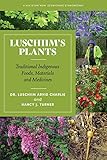Dr. Luschiim Arvid Charlie “is a respected elder and botanical expert of Cowichan Tribes, and a fluent speaker of his Hul’q’umi’num’ language. His knowledge of plants is truly remarkable and comes from deep training and experience, starting in his earliest childhood years.”
T his is how Nancy J. Turner introduces her co-author of “Luschiim’s Plants’, a book on the ethnobotany of the Coast Salish peoples of southern Vancouver Island and the Gulf Islands in British Columbia. The result of 15 years of collaboration, this book discusses native plants from seaweeds to trees.
his is how Nancy J. Turner introduces her co-author of “Luschiim’s Plants’, a book on the ethnobotany of the Coast Salish peoples of southern Vancouver Island and the Gulf Islands in British Columbia. The result of 15 years of collaboration, this book discusses native plants from seaweeds to trees.
One of the longest entries is for Western Red-Cedar (Thuja plicata) or Xpey’, one of the names it is known by in Hul’q’umi’num’. It has many uses throughout the life of indigenous peoples, being used both for diapers and coffins. Where the tree grows distinguishes the qualities of its wood. The swamp cedar has a high resin content is very heavy. Those from rocky bluffs in the mountains have very light wood.
In between, there are two more distinct forms. Plank cedar is from trees with no lower branches and easy to split. Canoe cedars have small branches closer to the base, so the grain is intertwined or twisted, preventing boats made from this wood from splitting if they hit a rock.
Various members of the rose family are important food sources. An unusual example is the Red Raspberry (Rubus idaeus; Tsulqama’). Mostly known from the interior of British Columbia, an early European botanist found it plentiful on Vancouver Island in the 1840s. But by the 1860s, it was reported as rare. Luschiim speculates these were transplanted here from interior hunting grounds, but did not thrive.
Wild ginger (Asarum caudatum; Tth’uletth’ie’) is another example of gardening by these indigenous people. While enjoyed for its flavorful stem, it also had important spiritual meaning. To keep them thriving Luschiim explains, “whatever was somewhat rare then, you’d transplant them; certain important plants were moved, such as…wild ginger.”
This book was honored with an Award of Excellence in Field Guides in 2023 from the Council on Botanical and Horticultural Libraries.
Reviewed by: Brian Thompson on May 20, 2024
Excerpted from the Summer 2024 issue of the Arboretum Bulletin